French Colonial
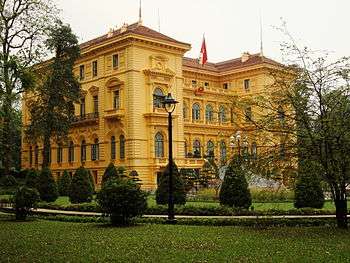
French Colonial is a style of architecture used by the French during colonization. Many former French colonies, especially those in Southeast Asia, have previously been reluctant to promote their colonial architecture as an asset for tourism; however, in recent times, the new generation of local authorities has somewhat 'embraced' the architecture and advertise it.[1] French colonial architecture has a long history, beginning in North America in 1604 and being most active in the Western Hemisphere (Caribbean, Guiana, Canada, Louisiana) until the 19th century, when the French turned their attentions more to Africa, Asia, and the Pacific.[2]
In Canada
French settlements in Canada date back to the mid-16th century and until the annexion of Quebec by the British Crown after the Treaty of Paris (1763), French Canada alongside with Louisiana, was immensely prosperous. Hence the abundant architectural legacy from that period particularly in Quebec City but also in Montreal. Most buildings constructed during the French colonial period utilized a heavy timber frame of logs installed vertically on a sill, poteaux-sur-sol, or into the earth, poteaux-en-terre. An infill of lime mortar or clay mixed with small stones (pierrotage) or a mixture of mud, moss, and animal hair (bousillage) was used to pack between the logs. Many times the infill would later be replaced with brick. This method of construction was used in the Illinois Country as well as Louisiana. General characteristics of a French Colonial dwelling included a raised basement which would support the floor of the home's primary living quarters. Exterior stairs were another common element; the stairs would often climb up to a distinctive, full-length veranda or "gallery," on a home's façade. The roof over the veranda was normally part of the overall roof. French Colonial roofs were either a steep hipped roof, with a dormer or dormers, or a side-gabled roof. The veranda or gallery was often accessed via French doors. French Colonial homes in the American South commonly had stuccoed exterior walls.[3]
.jpg) Quebec City presents probably the finest example of urban colonial architecture in North America
Quebec City presents probably the finest example of urban colonial architecture in North America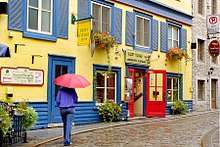 Old Quebec (City) was listed as a UNESCO Heritage Site in 1985
Old Quebec (City) was listed as a UNESCO Heritage Site in 1985 The manoir Boucher-De Niverville, located in Trois-Rivières, in Quebec province was built in the mid-17th century
The manoir Boucher-De Niverville, located in Trois-Rivières, in Quebec province was built in the mid-17th century The Château Ramezay, is one of the best preserved mansion in Montreal, built in 1705.
The Château Ramezay, is one of the best preserved mansion in Montreal, built in 1705.- The Maison François-Jacquet-Dit-Langevin, located in the heart of Old Quebec, was built in 1675.
- LeBer-LeMoyne House, was an important trading post when it was built in the late 17th century. It is today in historical museum of Montreal.
 Cathedral-Basilica of Notre-Dame de Québec, started in 1647, is the oldest church in the Americas north of the Spanish colonies in Florida and New Mexico.
Cathedral-Basilica of Notre-Dame de Québec, started in 1647, is the oldest church in the Americas north of the Spanish colonies in Florida and New Mexico.
In the United States
French Colonial was one of four domestic architectural styles that developed during the colonial period in what would become the United States. The other styles were Colonial Georgian, Dutch Colonial, and Spanish Colonial. French Colonial developed in the settlements of the Illinois Country and French Louisiana. It is believed to have been primarily influenced by the building styles of French Canada and the Caribbean.[4] It had its beginnings in 1699 with the establishment of French Louisiana but continued to be built after Spain assumed control of the colonial territory in 1763. Styles of building that evolved during the French colonial period include the Creole cottage, Creole townhouse, and French Creole plantation house.[5]
 Ursuline Convent in New Orleans, built c. 1752. It is the oldest-surviving building from the French colonial period in New Orleans. It is an example of stuccoed brick construction.
Ursuline Convent in New Orleans, built c. 1752. It is the oldest-surviving building from the French colonial period in New Orleans. It is an example of stuccoed brick construction.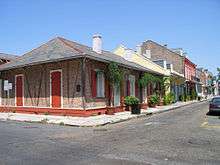 Gabriel Peyroux House in New Orleans, built c. 1780, is an example of briquette-entre-poteaux (brick-between-post) construction.
Gabriel Peyroux House in New Orleans, built c. 1780, is an example of briquette-entre-poteaux (brick-between-post) construction.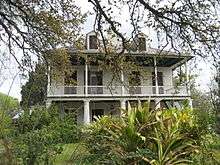 Lorreins Plantation, aka Old Spanish Customs House, in New Orleans, built c. 1784
Lorreins Plantation, aka Old Spanish Customs House, in New Orleans, built c. 1784 Destrehan Plantation near Destrehan, St. Charles Parish, Louisiana, built c. 1787, portions were altered in 1840 to reflect the Greek Revival style.
Destrehan Plantation near Destrehan, St. Charles Parish, Louisiana, built c. 1787, portions were altered in 1840 to reflect the Greek Revival style.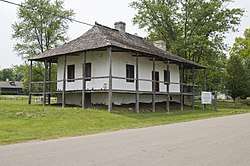 Bequette-Ribault House in Ste. Geneviève, Missouri, c. 1789 is an example of poteaux-en-terre construction.
Bequette-Ribault House in Ste. Geneviève, Missouri, c. 1789 is an example of poteaux-en-terre construction. Louis Bolduc House Museum, in Ste. Geneviève, Missouri, c. 1792 is an example of poteaux-sur-sol construction.
Louis Bolduc House Museum, in Ste. Geneviève, Missouri, c. 1792 is an example of poteaux-sur-sol construction..jpg) Parlange Plantation House in Mix, Louisiana, was built c. 1754 and is an early example of French Colonial architecture in the United States.
Parlange Plantation House in Mix, Louisiana, was built c. 1754 and is an early example of French Colonial architecture in the United States.
In Southeast Asia
There are some colonial buildings as France's legacy in the area, dating back to the 19th and 20th French Indochina colony. Most of them are located in Hanoi, Ho Chi Minh City and Phnom Penh. Saigon (present-day Ho Chi Minh City) and Hanoi as the capitals of Indochina, respectively in 1887–1902 and 1902-1945, present the most exceptional and among the best preserved French colonial buildings in the region including:
- In Hanoi:
- Presidential Palace
- Long Biên Bridge, formerly Paul Doumer Bridge
- National Museum of Vietnamese History, formerly École française d'Extrême-Orient
- Hanoi Opera House
- St. Joseph's Cathedral
- Hôtel Metropole
- Sites of Indochina Medical College and Université Indochinoise in Hanoi
- Ministry of Foreign Affairs building
- Tonkin Palace or State Guesthouse, formerly Bắc Bộ phủ (Palais du Résident Supérieur Tonkin)
- Most foreign embassies in Hanoi are housed in French-Colonial villas
- In Ho Chi Minh City (Saigon):
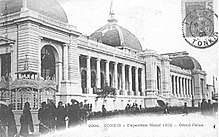 Palais d'Expositions built for the Hanoi Exhibition, destroyed during WWII
Palais d'Expositions built for the Hanoi Exhibition, destroyed during WWII
.jpg) Hanoi Opera House modeled on the Palais Garnier in Paris
Hanoi Opera House modeled on the Palais Garnier in Paris- The Municipal Theatre, in Ho Chi Minh City
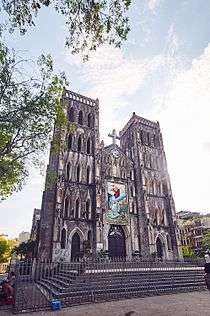 St. Joseph's Cathedral, Hanoi resembling Notre Dame de Paris
St. Joseph's Cathedral, Hanoi resembling Notre Dame de Paris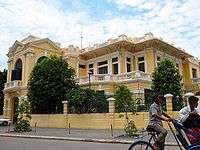 A French colonial villa located in Phnom Penh, Cambodia
A French colonial villa located in Phnom Penh, Cambodia- Ho Chi Minh City Hall in Vietnam
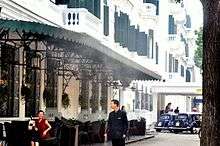 A corner of Hôtel Metropole in Hanoi
A corner of Hôtel Metropole in Hanoi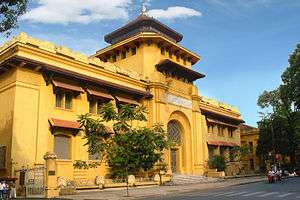 Site of Université Indochinoise in Hanoi
Site of Université Indochinoise in Hanoi.jpg) Tonkin Palace in Hanoi, formerly housing the French governor of Tonkin
Tonkin Palace in Hanoi, formerly housing the French governor of Tonkin.jpg) A typical colonial house in Luang Prabang, Laos
A typical colonial house in Luang Prabang, Laos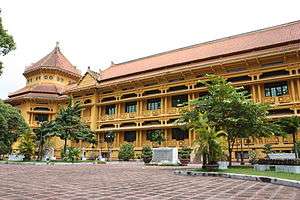 National Museum of Vietnamese History in Hanoi, formerly the first École française d'Extrême-Orient
National Museum of Vietnamese History in Hanoi, formerly the first École française d'Extrême-Orient
See also
- American colonial architecture, which states that by 1770 the briquette-entre-poteaux replaced earlier types of French Colonial construction.
- Creole cottage
References
- ↑ http://www.eng.hochiminhcity.gov.vn/abouthcmcity/Lists/Posts/Post.aspx?CategoryId=10&ItemID=5440&PublishedDate=2005-03-13T11:19:09Z/
- ↑ http://www.mqup.ca/architecture-and-urbanism-in-the-french-atlantic-empire-products-9780773553149.php
- ↑ Bigolin, Steve. "The Landmarks of Barb City", Daily Chronicle, 28 February 2005. Retrieved 15 February 2007.
- ↑ Gamble, Robert Historic architecture in Alabama: a guide to styles and types, 1810-1930, page 180. Tuscaloosa, Alabama: The University of Alabama Press, 1990. ISBN 0-8173-1134-3.
- ↑ "French Creole Architecture". Louisiana Division of Historic Preservation. National Park Service's National Register of Historic Places. Retrieved 2008-08-02.